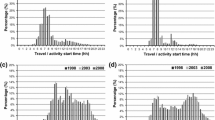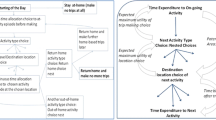Abstract
Most of the earlier activity based models (ABMs) largely relied on a tour-based modeling paradigm which explicitly predicts tour frequency and then adds details including stop frequency, order, and location of stops within each tour. The current study is part of new tour formation design framework for an ABM in which the underlying tour structure and the stop frequency within tours emerge from temporal, sequencing, and locational preferences of activities that the traveler intends to participate during the day. In order to do this, the study developed a modified rank-ordered logit (ROL) framework that is capable of modeling sequence, locations, as well as the underlying tour structure of all activity episodes simultaneously in an integrated manner. Model estimation with the household survey data, provided several important behavioral insights into underlying choices that drive tour formation. Specifically, the study uncovered pairwise ordering preferences among episodes of different activity purposes, clustering tendencies among episodes of same activity purpose, the impact of supply side activity opportunities on the location and sequence choice dimensions, and impedance effects (including distance and mode and time-of-day logsums) on location and tour break dimensions. The developed models are incorporated in the operational ABM structure adopted for three major cities (Columbus, Cleveland, and Cincinnati) in Ohio.


Similar content being viewed by others
Notes
An at-work sub-tour is defined as a sequence of trips that start and end at the primary workplace (for example, all lunch trips at work place constitute an at-work sub-tour).
Please note that the Rank Ordered Logit (ROL) model used in this study is different from the ordered logit model used for analyzing ordinal variables (Paleti and Bhat 2013).
To test scale heterogeneity, we used a nested logit specification where the choice set was duplicated for each sub-sample and placed under a separate nest with a linkage across all model coefficients except for the scale parameters. Polydoropoulou and Ben-Akiva (2001) and Paleti et al. (2014) used similar techniques for uncovering scale heterogeneity in revealed and stated preference datasets. However, both unconstrained optimization of the resulting log-likelihood function and grid search over an extended range of scale parameters did not indicate scale parameters significantly different from 1.
Deviation is calculated as follows: (OH + HD − OD) where OH is Origin-to-Home distance, HD is Home-to Destination distance, and OD is Origin-to-Destination distance.
References
Axhausen, K.W., Gärling, T.: Activity-based approaches to travel analysis: conceptual frameworks, models, and research problems. Transp. Rev. 12(4), 323–341 (1992)
Beggs, S., Cardell, S., Hausman, J.: Assessing the potential demand for electric cars. J. Econom. 17(1), 1–19 (1981)
Ben-Akiva, M.E., Lerman SR, : Discrete choice analysis: theory and application to travel demand, vol. 9. MIT press, Cambridge (1985)
Bhat, C.R., Goulias, K.G., Pendyala, R.M., Paleti, R., Sidharthan, R., Schmitt, L., Hu, H.-H.: A household-level activity pattern generation model with an application for Southern California. Transportation 40(5), 1063–1086 (2013)
Bowman, J.L., Bradley, M.: DAYSIM Activity and Travel Schedule Simulator Technical Documentation, Resource Systems Group, Inc. (2012)
Davidson, W., Vovsha, P., Freedman, J., Donnelly, R.: CT-RAMP family of activity-based models. In: Proceedings of the 33rd Australasian Transport Research Forum (ATRF) 2010. Citeseer
Fok, D., Paap, R., Van Dijk, B.: A rank-ordered logit model with unobserved heterogeneity in ranking capabilities. J. Appl. Econom. 27(5), 831–846 (2012)
Goulias, K.G., Bhat, C.R., Pendyala, R.M., Chen, Y., Paleti, R., Konduri, K.C., Huang, G., Hu, H.-H.: Simulator of activities, greenhouse emissions, networks, and travel (SimAGENT) in Southern California: Design, implementation, preliminary findings, and integration plans. In: Integrated and Sustainable Transportation System (FISTS), 2011 IEEE Forum on 2011, pp. 164–169. IEEE
Guevara, C.A., Ben-Akiva, M.E.: Sampling of alternatives in Logit Mixture models. Transp. Res. Part B: Methodol. 58, 185–198 (2013)
Kitamura, R.: Applications of models of activity behavior for activity based demand forecasting. In: Activity-based travel forecasting conference, New Orleans, Louisiana 1996
McFadden, D.: Modelling the Choice of Residential Location. University of California, Institute of Transportation Studies (1978)
Meeks, W.S., Sabina, E.E., Childress, S., van Slyke, C.D., Mullins III, J.A., Ziering, E.A., Rossi, T.F.: TourCast: Trade-offs in Activity-Based Model Implementations. In: Transportation Research Board 92nd Annual Meeting 2013, vol. 13-3712
Paleti, R., Bhat, C.R.: The composite marginal likelihood (CML) estimation of panel ordered-response models. J. Choice Model. 7, 24–43 (2013)
Paleti, R., Vovsha, P., Givon, D., Birotker, Y.: Joint modeling of trip mode and departure time choices using revealed and stated preference data. Transp. Res. Record 2429, 67–78 (2014)
Paul, B.M., Vovsha, P., Hicks, J.E., Vyas, G., Livshits, V., Jeon, K.: Generation of Mandatory Activities and Formation of Mandatory Tours: Application to the Activity-Based Model for Phoenix, AZ. In: Transportation Research Board 94th Annual Meeting 2015, vol. 15-5149
Pinjari, A.R., Bhat, C.R.: Activity-based travel demand analysis. A Handbook of Transport Economics 10, 213–248 (2011)
Polydoropoulou, A., Ben-Akiva, M.: Combined revealed and stated preference nested logit access and mode choice model for multiple mass transit technologies. Transp. Res. Record 1771, 38–45 (2001)
Srinivasan, S., Bhat, C., Holguin-Veras, J.: Empirical analysis of the impact of security perception on intercity mode choice: a panel rank-ordered mixed logit model. Transp. Res. Record 1942, 9–15 (2006)
Vyas, G., Vovsha, P., Paleti, R., Givon, D., Birotker, Y.: Investigation of Alternative Methods for Modeling Joint Activity Participation. In: Transportation Research Board 94th Annual Meeting 2015a, vol. 15-1908
Vyas, G., Vovsha, P., Paul, B., Givon, D., Livshits, V.: Allocation of Individual Non-Mandatory Activities to Day Segments in the Tour Formation Procedure: Application to the Activity-Based Models for Jerusalem, Israel and Phoenix, AZ. In: Transportation Research Board 94th Annual Meeting 2015b, vol. 15-4462
Acknowledgments
The authors would like to thank four anonymous reviewers whose comments helped improve an earlier version of the paper considerably.
Author information
Authors and Affiliations
Corresponding author
Rights and permissions
About this article
Cite this article
Paleti, R., Vovsha, P., Vyas, G. et al. Activity sequencing, location, and formation of individual non-mandatory tours: application to the activity-based models for Columbus, Cincinnati, and Cleveland, OH. Transportation 44, 615–640 (2017). https://doi.org/10.1007/s11116-015-9671-5
Published:
Issue Date:
DOI: https://doi.org/10.1007/s11116-015-9671-5




